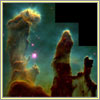

|
|
More than just a pretty picture
The Eagle Nebula image was taken on April 1, 1995, by the
Hubble's Wide Field and Planetary Camera 2. Like a digital
camera, the WFPC2 uses charge-coupled devices (CCDs) rather
than film to record images. CCDs have an array of
light-sensitive elements called pixels that turn light falling
on them into electrical signals. As we'll see, all the hard
work of preparing the final image involves knowing how to
interpret each of those signals, removing the "fingerprints"
of the camera itself, and turning the signals into
measurements of how bright the light is at specific points in
the sky.
The WFPC2's field of view is about 1600 by 1600 pixels, which
makes it roughly equivalent to a 2.5 megapixel digital camera.
While the final image is not true color, it is closer to what
your eye would see if you went there than the picture you
would get with color film.
Before we begin fashioning the image, I need to reveal why the
final picture seems to have had a big bite taken out of its
upper-right quadrant.
|
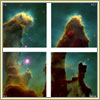

|
|
Size matters
The WFPC2 actually has four separate cameras—three Wide
Field (WF) cameras and one Planetary Camera (PC), known as
PC1. As this illustration shows, each camera images one
quarter of the scene being photographed. All except the PC1,
that is. It records a magnified view of its portion, which
allows astronomers to see finer detail in that corner of the
overall image. The final picture would look strange this way,
so we need to scale the PC1 image down in size to
proportionally match the other three images. (See previous
picture for resized PC1 image.) Now you see why all pictures
taken by Hubble's WFPC2 instrument have a stair-step shape.
Let's back up and start at the beginning. A warning: the raw
image beamed down from Hubble is a far cry from its polished
final version.
|
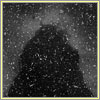

|
|
Raw Deal
I told you it would look different! Here's why: First, and
most obviously, we're looking through a blizzard of cosmic
radiation and other spurious signals that we'll soon get rid
of. Second, we're only looking at an image from the PC1
camera; we'll get to the images from the three WF cameras in a
moment. Third, we're only looking at one of four colors of
light that each of the four cameras records. (Just as a TV
makes a color picture by combining red, green, and blue
images, our final color image will combine images taken
through different filters—more on that later.)
Finally, we're only looking at one of 32 different images that
go into producing the final picture. That's because each of
the four cameras takes
two images through each of its four filters. Why the
duplicate pictures? Let me explain.
|
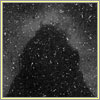

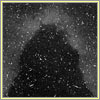

|
|
Cosmic graffiti
Each of the WFPC2's four cameras takes two images with
each of its four filters for a good reason. Most of the
"snowflakes" you see here are cosmic rays—atomic nuclei
whizzing about space at close to the speed of light—that
struck the CCD at the moment the image was made. Each cosmic
ray leaves a streak across the CCD. Like scratches on a
photographic negative, these streaks interfere with the scene
we want to see, namely, the Eagle Nebula. Fortunately, cosmic
rays arrive randomly, so the marks they leave differ from
image to image. Click between the two "Cosmic Graffiti"
images, which were taken within moments of each other. Notice
how the cosmic-ray marks differ in each.
Now we need to clear away all that annoying cosmic "snow."
|
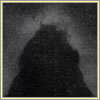

|
|
Goodbye to all that
This is the final cleaned-up image. How did we banish the
blizzard? First, we flagged sharp features appearing in one
image but not the other as cosmic-ray garbage and discarded
them. Then we combined the two "snow"-free images to improve
the signal-to-noise ratio. We also corrected for a number of
instrumental effects with names like "dark current," "flat
fields," and "charge transfer inefficiences." No need to bore
you with details of those effects, even though as a member of
the team that built the camera I spent a couple of years
figuring out how to characterize and remove them!
Despite all these efforts, some cosmic rays and other defects
remain that we need to jettison.
|
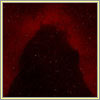

|
|
Unsavory characters
One way to find the remaining cosmic rays and other defects is
to compare the four images taken with the four different
filters. Another way is to compare the pictures with the image
profile of a point source such as a star. If we see a sharp
bit of light that doesn't have the right profile to be a star,
it's probably a cosmic ray residual or other defect that we
need to flag and remove. This image shows the remaining
undesirable bits flagged in white against the desired image,
shown for the moment in red to ease visibility.
Now let's delete the remaining "flurries" and see what we've
got.
|
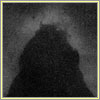

|
|
Spanking clean
This is the final, fully cleaned-up version of the PC1
image—or at least one of the PC1 images. Remember that a
picture was taken with the PC1 through each of four filters.
Each filter records light emanating from the target
object—in our case the Eagle Nebula—in very
specific parts of the visible-light spectrum.
Different types of atoms, it turns out, emit light at very
specific wavelengths—that is, very specific colors. (For
more on this, see the "Decoding Cosmic Spectra" feature
elsewhere on this Web site.) This allows astronomers like me
to take images that only show the light coming from specific
types of atom. For the Eagle Nebula image, the WFPC2 used
filters that took images in the light of three kinds of atoms:
hydrogen atoms, sulfur atoms with one electron removed (sulfur
ions), and oxygen atoms with two electrons removed (doubly
ionized oxygen). A fourth filter sees only starlight, which
lights up the dust that is mixed in with the nebula's gas.
The PC1 image that we've been manipulating was taken with the
oxygen filter. The first step in getting the PC1 image
together with its Wide Field mates is to obtain cleaned-up
versions of the three WF images also taken with the oxygen
filter.
|
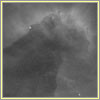

|
|
Number two
This is the cleaned-up version of the oxygen-filter image
taken by the WF2 camera, that is, the camera that took the
image of the upper left quadrant of the final image. Note that
we have reoriented this image and the next two from the way
the WFPC2 actually took them, in order to make them "upright."
|
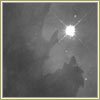

|
|
Number three
This is the cleaned-up version of the oxygen-filter image
taken by the WF3 camera, that is, the camera that took the
image of the lower left quadrant of the final image.
|
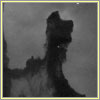

|
|
Number four
This is the cleaned-up version of the oxygen-filter image
taken by the WF4 camera, that is, the camera that took the
image of the lower right quadrant of the final image.
Let's now combine the four images into a single portrait of
the Eagle Nebula.
|
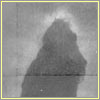

|
|
Come together
Each of the four images has geometrical distortions similar to
those you see when you look through a magnifying glass. To
combine the images of the four different cameras into a
single, accurate picture of the nebula, we need to map and
remove those distortions. Once we've done so, the four images
fit together nicely, giving us this single mosaic image of the
Pillars of Creation, showing light coming through the oxygen
filter.
Now the picture is beginning to resemble its final self. But
who wants those ugly seams? Let's erase them.
|
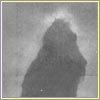

|
|
Wrinkle free
Okay, we've gotten rid of those unsightly lines. But remember,
this image only shows light originating from doubly ionized
oxygen atoms.
Let's have a look at similarly processed images taken in the
light of hydrogen atoms and sulfur ions. As you go through the
images, notice the subtle differences between them. Comparing
the light coming from different types of atoms is what allows
us to turn what otherwise might be just a pretty picture into
detailed knowledge of the physical conditions from region to
region within the nebula. More on that in a minute.
|
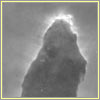

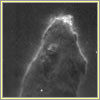

|
|
A striking couple
Here are images of the Eagle Nebula taken in the light given
off by its hydrogen atoms (1) and its sulfur ions (2). Click
between the two pictures to compare how the nebula looks in
the two images.
If you're curious as to where these atoms' so-called emission
lines fall on the visible-light spectrum, see the graph below.
The wavelengths of the light picked up by the WFPC2's hydrogen
and sulfur filters are 6563 and 6725 angstroms, respectively.
(One angstrom is equal to one ten-billionth of a meter.) The
corresponding wavelength for light coming through the oxygen
filter is 5007 angstroms.

We now have three images, each showing us light from a
different type of atom. Now, the best way to see the
differences among these three images is to make each of the
three a different color, then use our color vision to tell us
how the nebula's properties are changing from place to place.
|
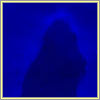

|
|
Blue sky
Here, we have assigned the color blue to the oxygen-filter
image.
|
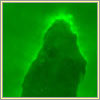

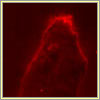

|
|
Heavenly hues
We've cast the hydrogen-filter image in green and the
sulfur-filter image in red. Compare the three color images to
see how the colors enhance the subtle structural variations
that the two pictures reveal in the nebula.
Now for the grand finale—combining all three processed
color images.
|


|
|
The Eagle Nebula
Here is the final, fully processed photograph that NASA
released in 1995. Now, what does the image tell us about what
we're seeing? Basically we're looking at dense clouds of
molecular hydrogen gas and dust that form just one part of the
Eagle Nebula. This is a large area: from top to bottom, the
pillar at left extends about four light-years, or the distance
light travels in four years going at roughly 186,000 miles per
second!
Parts of the clouds, particularly the finger-like projections
you can see at various points along the pillars, are dense
enough to collapse under their own weight, forming young
stars. These embryonic stars continue growing as long as they
can draw mass from the surrounding clouds. But ultraviolet
light from massive newborn stars (unseen off the top edge of
the picture) is eating away at the pillars, essentially
evaporating the gas in these clouds. Such "photoevaporation"
gives shape to the pillars and illuminates the fog of gas
burning off their edges.
If you could go back 4.5 billion years and watch as our sun
and solar system formed, you would probably see a region very
much like what you see in the Eagle Nebula today. There's a
lot more science having to do with understanding the detailed
physics of the gas and what images like this tell us about how
stars form. But now you have at least a rough idea of both
what we're learning from this single snapshot from the Hubble
Space Telescope and what it takes to produce all those
gorgeous images taken in orbit. For more on how the Hubble
works, see the official Hubble Web site at
http://hubblesite.org.
|

|

|

